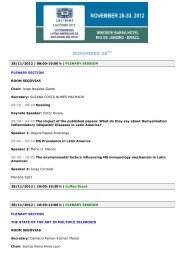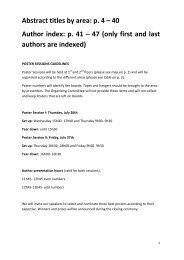Keynote Conference - Interevent
Keynote Conference - Interevent
Keynote Conference - Interevent
Create successful ePaper yourself
Turn your PDF publications into a flip-book with our unique Google optimized e-Paper software.
Symp#26 RNA regulation - Canadian Society for Cell Biology<br />
Chairs and speakers Jean Pierre Perrault and Carla Columbano<br />
Impact of G-quadruplex structures on the human transcriptome<br />
Jean-Pierre Perreault and Jean-Denis Beaudoin<br />
Groupe ARN/RNA group, Département de biochimie, Faculté de médecine et des sciences de la santé, Université de Sherbrooke,<br />
Sherbrooke, QC, J1H 5N4, Canada (Jean-Pierre.Perreault@USherbrooke.ca)<br />
Given that greater than 90% of the human genome is expressed, it is logical to assume that post-transcriptional regulatory<br />
mechanisms must be the primary means of controlling the flow of information from mRNA to protein. Guanine-rich nucleic acid<br />
sequences can fold into non-canonical, four stranded helical structures called G-quadruplexes. Initially, we have developped a robust<br />
approach that includes in silico, in vitro and in cellulo experiments permitting an in-depth evaluation of the global impact of Gquadruplexes<br />
as translational repressors. Briefly, sequences including potential G-quadruplexes were selected within 9 distinct genes<br />
encoding proteins involved in various biological processes. Six of these sequences were observed to fold into G-quadruplex structures<br />
in vitro, all of which exhibited translational inhibition in cellulo when linked to a reporter gene. In addition, the impact of single<br />
nucleotide polymorphism was shown to be important in the formation of G-quadruplexes located within the 5’-untranslated region of<br />
an mRNA. Subsequently, the same approach was applied in order to study to evaluate the presence of G-quadruplex structures within<br />
human 3'-UTRs. Specifically, two potential G-quadruplex sequences located in the 3'-UTR of the low density lipoprotein receptorrelated<br />
protein 5 (LRP5) gene and the fragile X mental retardation autosomal homolog 1 (FXR1) gene were chaarcterized. Both of<br />
these G-quadruplex structures increases by 2-fold the gene expression of a reporter gene by stimulating the polyadenylation of its<br />
mRNA throughout an alternative site located downstream of the canonical site of their corresponding 3'-UTR. Sequence analysis, site<br />
directed mutagenesis, miRNA regulation network analysis and G-quadruplex ligand experiments were performed to define rules<br />
governing this phenomenon. In light of these results, we suggest that 3'-UTR G-quadruplexes can regulate alternative polyadenylation<br />
sites, leading to the expression of shorter transcripts, and can interfer with the miRNA regulatory network of a specific mRNA. In light<br />
of these results, the G-quadruplexes represent a class of RNA motif that is broadly distributed in the cellular transcriptome and have<br />
important impact on mRNA species.<br />
Identification of proteins regulating the RNA exosome<br />
Carla Columbano Oliveira<br />
Departamento de Bioquímica, Instituto de Química, Universidade de São Paulo<br />
In eukaryotes, many posttranscriptional processing events are necessary for the synthesis of mature RNAs. mRNAs, tRNAs, rRNAs,<br />
snRNAs and snoRNAs are processed through several steps that involve specific reactions between RNA and proteins. In fact, most<br />
cellular RNAs are associated with proteins, forming ribonucleoprotein complexes (RNPs), which participate in different aspects of<br />
gene expression.<br />
The main focus of our laboratory has been the study of the posttranscriptional control of gene expression through the functional and<br />
structural characterization of proteins that regulate processing of different types of RNA. We will show the identification and<br />
functional characterization of Saccharomyces cerevisiae proteins that interact with and regulate the RNA exosome, a protein complex<br />
involved in processing and degradation of all types of RNA. Nop53p and Nop8p are nucleolar proteins involved in the maturation of<br />
the large ribosomal subunit and regulate the RNA exosome during this process in different ways. While Nop53p activates the<br />
exosome, Nop8p inhibits it. These observations led to the hypothesis that the interactions between different proteins and the<br />
exosome are responsible for directing the complex to its substrates, and for controlling its activity.<br />
Inhibition of RNA Polymerase I as a Strategy to Treat Cancer<br />
Megan J. Bywater 1 , Katherine M. Hannan 1 , Gretchen Poortinga 1 , Joanna C. Chan 1 , Elaine Sanij 1 , Nadine Hein 1 , Carleen Cullinane 1 ,<br />
Denis Drygin 2 , William G. Rice 2 , Ricky W. Johnstone 1,3 , Grant A. McArthur 1,3 , Ross D. Hannan 1,3 and Richard B. Pearson 1,3 .<br />
1 Division of Cancer Research, Peter MacCallum Cancer Centre, St Andrews Place, East Melbourne, Vic, Australia; 2 Cylene<br />
Pharmaceuticals Inc., 5820 Nancy Ridge Drive, San Diego, CA 92121, USA; 3 Sir Peter MacCallum Department of Oncology, University<br />
of Melbourne, Melbourne Australia.<br />
Morphologic abnormalities of the nucleolus, the site of transcription of the ribosomal genes (rDNA) by RNA Polymerase I (Pol I), have<br />
been recognized as diagnostic for cancer for more then a century. Furthermore, accelerated ribosome biogenesis is invariably<br />
associated with malignant transformation. Nevertheless, a critical, unresolved question has been whether the accelerated ribosome<br />
biogenesis responsible for the nucleolar changes is required for maintenance of the malignant phenotype.<br />
Here we show that the PI3K/AKT pathway, deregulated in a high proportion of human tumours, is a critical regulator of ribosome<br />
biogenesis. Constitutively active AKT is sufficient to drive rRNA synthesis, ribosome biogenesis and cell growth. Furthermore, AKT<br />
cooperates with c-MYC to activate rRNA synthesis and ribosome biogenesis identifying the AKT/mTORC1/MYC network as a master<br />
controller of cell growth. Consistent with this concept, AKT activity is required for maximal activation of rRNA synthesis and tumour<br />
formation in the E�-Myc mouse model of Burkitt’s lymphoma (1). Our findings raise the exciting possibility that malignant diseases<br />
characterized by unrestrained cellular growth may be vulnerable to therapeutic strategies that target ribosome biogenesis.<br />
To directly test this hypothesis, we used genetic manipulation and a novel selective small molecule inhibitor of Pol I transcription (CX-<br />
5461) (2), to provide the first definitive evidence that accelerated rDNA transcription and nucleolar integrity are necessary for<br />
oncogenic activity in hematologic tumour cells. Further, we show that Pol I transcription can be targeted in vivo to therapeutically<br />
treat tumors in both genetically engineered and xenograft models of lymphoma and leukemia through the non-genotoxic activation<br />
of p53-dependent apoptosis, while sparing normal cells of hematological lineages. Thus, selective inhibition of Pol I transcription, a so<br />
called ‘”house keeping” process, can serve as a novel therapeutic strategy for the treatment of cancer (3).<br />
(1) Chan J.C, et al (2011) Science Signaling 4 (188), ra56, (2) Drygin, D et al., (2011) Cancer Res, 71(4):1418-3<br />
(3) Bywater, M.J. et al (2012) Cancer Cell (accepted for publication)<br />
78





